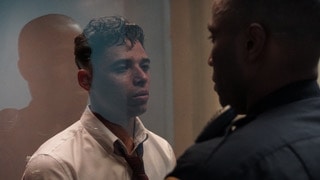Reinaldo Marcus Green’s directorial debut, Monsters and Men, is a steadfast depiction of police brutality and the effect it has on a neighborhood and the police force within that community. The film follows three characters whose lives never cross paths, but are forever changed following the upload of cellphone footage showing a police officer shooting Darius Larson, an unarmed black man.
By way of the roaring New York City trains and police sirens, the gloss and glamor of the big screen are non-existent, which brings to life the film’s authenticity. We are catapulted into Brooklyn’s Bedford Stuyvesant.
“What is the right thing to do? How far will I go to do it? These are questions we are not ourselves these questions every day. How much am I willing to sacrifice?,” Anthony Ramos asked the audience at the at BAM Harvey Theater in Brooklyn during the film’s New York premiere. Ramos plays Manny Ortega, the young man that uploads the footage to YouTube, thus bringing national attention to the case. The buzz from the footage unjustly lands Manny in jail.

Another character Dennis (John David Washington), is a black cop in the same precinct as Larson’s shooter. “The role was intriguing because it’s from both the blue and the black,” responded Washington when answering why he took the role. Throughout the film, his character struggles with his identity. In one scene, Dennis misses his son’s spelling bee followed by the next morning he strongly objects his son wearing a cop shirt to Parent Appreciation Day. Dennis is constantly juggling decisions that affect himself, his family and his community and we find out sacrifices must be made in order to protect one.

The third character, Zach (Kelvin Harrison Jr.), is emotionally pulled between a potential professional baseball career and the activism movement formed around Larson’s death. “I have this privilege and talent, but what do I want? I am experiencing feelings. I want to speak out and do things for my community. There is no right or wrong way to help. I can honor my parents and find that balance,” Harrison Jr. annunciated into the microphone.
We never see the trigger getting pulled in the video, but throughout the film we bear witness to reactions from community members and police officers while listening to loose interpretations of their perspectives. Initially, waiting to see the video seems like it would be a big reveal; we would see the truth of what happened and the justice system would take care of the rest. However, rather quickly, we discover that the ‘trigger pull’ moment of the video is of little importance. That is to say, the video itself becomes the driving force that expedites a flawed system where protecting your own outweighs a just process.
On one hand, the video justified the cops moving forward framing Manny to protect an officer that had several unresolved prior disciplinary cases. On the other hand, the video justified the young black teens to rally for the wrongful death of their beloved community member.
To the audience, the video showed us that sometimes we can’t hide the truth and sometimes the truth does not matter. We have replaced eyewitness accounts with footage, but the systems that are in play have existed long before cameras were on every street corner. And even when these unfortunate situations are spelled out on camera, the narrative was written long before the trigger was pulled.
The human response is almost predictable at this juncture. In questioning ourselves, we begin to rewrite the actions of something clearly caught on camera. Nevertheless, life moves on regardless of which side you’re fighting for. The police continue to stop and frisk, familiarizing the hands of Bed-Stuy’s next generation with the hoods of their cars. Meanwhile, the trigger happy cop gets placed on paid leave.
All the while you begin to see how being on the side of these poor victims is somehow a shame. Their prayer circles get broken up outside the bodega where Mr. Larson was killed and they gather in basements to prepare signs and practice chants for their organized march.
The director grieves the reality that “you don’t know what happens to Manny. He is gone. We lost him. Maybe not to death, but he’s gone.”
There are no resolutions or lessons learned at the close of this film. Instead, we are struck by the initial shock, which turns to dismay as the credits roll. By the time we are heading home, we are back to the starting point admitting that this awful situation plays out often and across the country. And we have no answers.
Monsters and Men is availible now in theaters


Leave a Reply